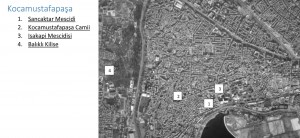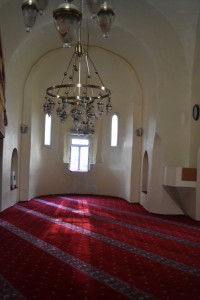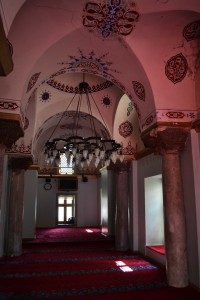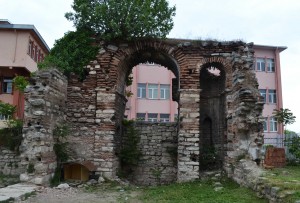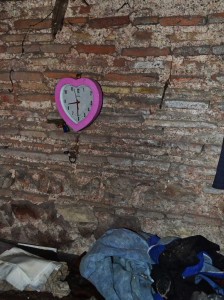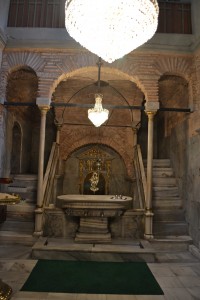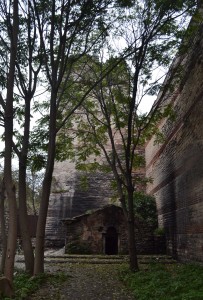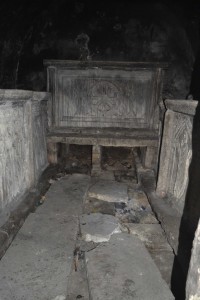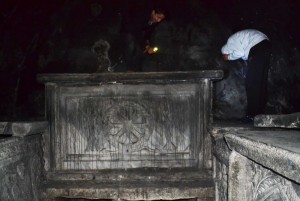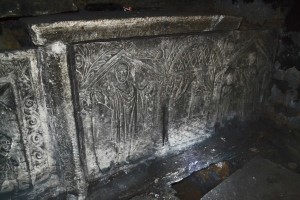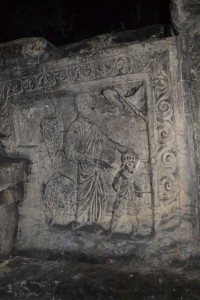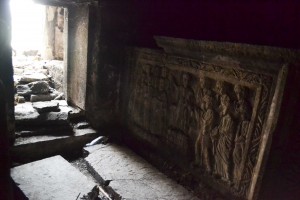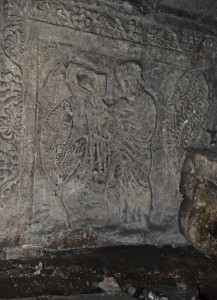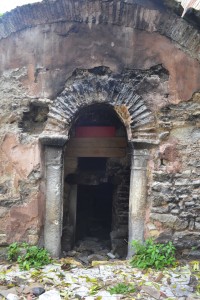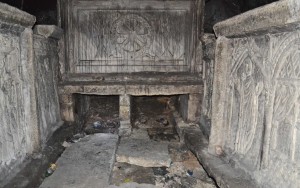Archive for November 1st, 2015
This is the south-central area of walled Constantinople. It is a region of quiet streets and little building activity. The absence (as yet) of urban renewal means that community structures are still intact. Nowhere is this more obvious than at Kocamustafapaşa Camii, the descendant of the ancient Church of St Andrew in Krisei. Apart from this building, the Byzantine monuments are fragmented and widely separated. A short distance outside the walls is the Balıklı Monastery with a sacred spring that made this a place of pilgrimage since before Roman times.
Monastery church of Gastria/Sancaktar Mescidi
Kocamustafapaşa Camii/Church of St Andrew in Krisei/Sümbül Camii
İsakapı Mescidisi, Ibrahim Paşa Medresesi
Yenikapı
The Shrine of Zoodochus Pege/Balıklı Kilise/The Ayazma of Pege/Balıklı Meryem Ana Rum Ortodoks Manastırı
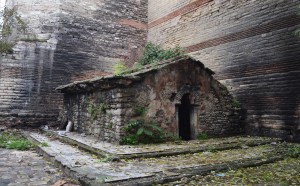

Posted November 1, 2015 Posted by Adam in Uncategorized
I don’t know how this little Byzantine beauty has survived for so long in the wild. It lay hidden beneath sediment (possibly from Byzantine times) until it was unearthed in 1988 by a team led by Ümit Serdaroğlu. Istanbul’s Municipality conducted a restoration of sorts in the early 1990s.
Since then, it has suffered the inevitable fate of a pristine site being exposed to an unpredictable population. The allegedly lovely frame around the door was stolen. Treasure hunters smashed the stone covers of the burial chambers and stole some of them. Several of these were later recovered and are now in the Archaeological Museum. The walls of the hypogeum were once covered in fresco decoration. This was restored in the 1990s and later covered in plaster. The plaster was allegedly removed by a misguided caretaker (Tunay p220). The walls are now blackened and no longer show any sign of fresco.
The hypogeum is a rectangular stone building of about 8 x 5m immediately to the south of tower 37 of the Theodosian walls (41.006643, 28.921958). This is the first tower north of Silivrikapı. The entrance is on the south side and leads into a sort of porch. From this tiny structure, one passes into the main burial chamber. A large, raised sarcophagus with a delicately carved christogram dominates the northern end. The left and right sides are occupied by two elaborately decorated burial chambers. These cannot properly be called sarcophagi as they are not wholly enclosed by stone. Nonetheless their marble carving is of excellent workmanship and in good condition. The floor between these chambers is a jigsaw of broken slabs that partially cover further burial places below.
The hypogeum was, until recently, in an area easily accessible by anyone but with its entrance closed by an iron grille. Since the thefts, high fences have blocked access but the grille has gone. Öztürk (2014) quotes a source who says that thieves stole the grille gate on the same day that it was installed by the Municipality. This may be an exaggeration but in any case, after a climb in from the direction of Silivrikapı one is able to go into the tomb.
The friendly youths who frequent the area refer to the hypogeum as the Tomb of the King. I am not sure that there is any evidence regarding the identity of whoever was buried here. The teenage guardians keep some fairly fierce-looking dogs here. The boys know the tombs well and, while not the most respectful of caretakers, do keep a watchful eye on anyone who comes in. A positive presence, on the whole.
The four marble panels on the floor-level burial sites are fine examples of marble carving, dated by Tunay to the late fourth and early fifth century. These panels appear to show what the occupants of the tombs wished to emphasise about their lives. The larger of these on the eastern side shows a triptych representing the house of the departed, with a cross in the centre, the pious-looking deceased on the left and a wife and child on the right. Nicely carved peacocks and flowers are above the house.
The smaller panel on this side shows a bearded man amongst the trappings of the good life, patting a small boy’s head with his left hand and holding an object with his right. According to Török (2001 p54) this shows the badge of office of the father’s career being passed to his son: that the boy is already on his way along the cursus honorum, the course of government appointments along which a man of high rank may pass. To me, it looks more like Abraham preparing to sacrifice Isaac.
The large panel on the western side shows a powerful man addressing a council. The smaller western relief has a dignitary surrounded by trees, perhaps an orchard. He is receiving something from a hand in the sky. We may assume that his future in the afterlife is assured.
The extent to which this building is actually a hypogeum (literally under ground) is debatable. Whilst it was clearly excavated from under the ground in the 1980s, its structure on a raised platform and with a doorway facing directly to ground level argues that it was intended to be an above-ground tomb.
At the moment, this building is one of the few remnants of old-school Istanbul, a relic of those times when the great monuments of Constantinople lay crumbling and open to investigation by any passer-by with a taste for being where one is not meant to be. It’s a mess at present, a home for the homeless, a garbage dump for those outside society. But it’s there in the wild, a rare Byzantine gem in its natural state.
Öztürk, F. (2014) Bizans Kral Mezarıyla Kumar Oynuyoruz. Radikal 19-10-2014. Available online at: http://www.radikal.com.tr/cevre/silivrikapi-hipojesi-artik-korunacak-1219729/ Accessed Sept 3, 2016
Öztürk, F. (2014) Silivrikapı Hipojesi Artık Korunacak. Radikal, 21-08-2014. Available online at: http://www.radikal.com.tr/turkiye/bizans-kral-mezariyla-kumar-oynuyoruz-1208073/ Accessed Sept 3, 2016
Török, L. (2005) Transfigurations of Hellenism: Aspects of Late Antique Art in Egypt AD 250 – 700. Brill, Leiden. Available online at: http://ixoyc.net/data/Fathers/631.pdf Accessed Sept 3, 2016
Tunay, M.I. (2001) Byzantine Archaeological Findings in Istanbul during the Last Decade. in: Necipoglu Nevra (ed.) Byzantine Constantinople: Monuments, Topography and Everyday Life. The Medieval Mediterranean: Peoples, Economies and Cultures, 400-1453, v. 33. Leiden: Brill pages 217–231
